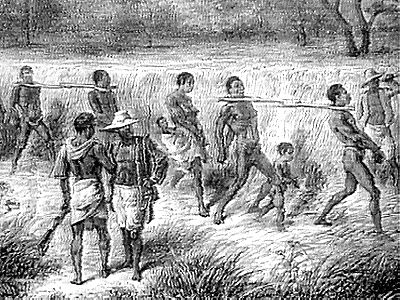The middle passage is the name for the journey of slaves to the coast of Africa for transportation. The slaves are people who were kidnapped, enslaved, captured or punished for a act of war. These people were taken away by African middle men who were capturing their own to make money by selling them to the European traders.
The slaves would be chained usually in threes or two. They were sometimes forced to carry things on their heads like ivory or water. They would walk for days or weeks until they reached the coast of Africa. Many were taken by canoes in rivers to the coast. Others were placed in forts to await sale. A variety of items were used in the sale of this ‘human merchandise’ ranging from guns to beads. 
The conditions in the forts for the enslaved women, men and children were inhumane. Having arrived from the long march or by river canoe, people were exhausted and hungry as well as disheartened and mentally and emotionally distressed. Many bore open wounds from acts of enslavement either by raid or war. A ship’s surgeon would examine them and eliminate those who were not fit for the journey. Many Africans died while waiting to be collected. There were also gender differences in the experiences of the enslaved, for example the women were targets for rape and physical abuse. Conditions were made worse by the long waiting period, which could vary from days to weeks to months. In 1846, 2000 African enslaved peoples were murdered in a fort in Lagos because Italian steamers feared the inevitable repercussions of trading illegally in slaves.
Monday, 30 June 2008